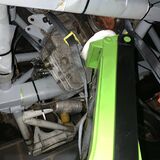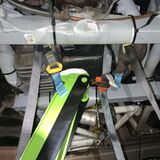How do you tell if your GKN differential's LSD is OK?
Discussion
I was wondering how do you tell if your LSD is working or if it needs refurbishing? My diff is the GKN from 1995.
I did a couple of quick tests with the rear wheels off the ground.
In neutral
Rotate the passenger side rear wheel and the driver's rotates in the same direction
Rotate the driver's side rear wheel and the passenger rear wheel ever so slightly moves in the same direction
In first gear
Rotate the passenger side rear wheel and the driver's rotates in the opposite direction
Rotate the driver's side rear wheel and the passenger rear wheel rotates in the opposite direction
When pulling away from standstill it is typically the driver's side rear wheel that breaks loose.
What do you think? Is the LSD working as it should or has it worn out and is now working as an open diff?
Also is 8 degrees rotational movement at the propshaft (handbrake on, in neutral) OK?
I did a couple of quick tests with the rear wheels off the ground.
In neutral
Rotate the passenger side rear wheel and the driver's rotates in the same direction
Rotate the driver's side rear wheel and the passenger rear wheel ever so slightly moves in the same direction
In first gear
Rotate the passenger side rear wheel and the driver's rotates in the opposite direction
Rotate the driver's side rear wheel and the passenger rear wheel rotates in the opposite direction
When pulling away from standstill it is typically the driver's side rear wheel that breaks loose.
What do you think? Is the LSD working as it should or has it worn out and is now working as an open diff?
Also is 8 degrees rotational movement at the propshaft (handbrake on, in neutral) OK?
O mage said:
You need to do some dynamic tests away from the neighbors. The car should easily spin both wheels up from a standstill, check marks on tarmac ..It should donut easily in both directions if it does that than id say its ok.
Thanks. At the moment, I've just installed a new clutch so I've got to bed that in first before really launching it. Surely there must be a way to test this in the garage.Thanks everyone for your suggestions.
I had a chat with John at Grantura Racing and it looks like my diff is showing its age. So this winter I’ll remove and get it refurbed. New bearings, seals and springs in the LSD.
Assuming it hasn’t been touched before then it’s had around 90k miles on it. The fixings look original and the bushes are all metalastic. The chassis looks good in that area with only the bit of surface rust here and there.
Even if the bushes look OK, would you recommend changing out for poly ones?
I had a chat with John at Grantura Racing and it looks like my diff is showing its age. So this winter I’ll remove and get it refurbed. New bearings, seals and springs in the LSD.
Assuming it hasn’t been touched before then it’s had around 90k miles on it. The fixings look original and the bushes are all metalastic. The chassis looks good in that area with only the bit of surface rust here and there.
Even if the bushes look OK, would you recommend changing out for poly ones?
NZ fan said:
I'm no expert but I don't think you can check the GKN diff by this method. I think the GKN design is a geared, torque-sensitive mechanical limited-slip differential which works in a very different way to a friction type LSD. It has to be transmitting a significant amount of torque from the input before it starts to limit the slip. So I don't think you can do a simple check like this.
^^^
this is correct. if you google "helical torque biasing differential" you will find how they work. there are no clutches as such. they have pairs of long overlapping helical gears instead of spider gears and side gears like a normal diff. they don't require LSD oil
normal open diff oil is what they are made for. i don't think rebuild parts are available anymore? hope I'm wrong as i also have one.
because they don't have a lot of drag when one wheel is rotated faster than the other and they don't require LSD oil, they are popular in front wheel drive rally cars where the oil is shared with the rest of the gearbox and a conventional LSD would inhibit steering. Quaife is a popular manufacturer of these helical torque biasing differentials. if it helps diagnose the condition of yours, mine will always spin both wheels when provoked and on a wet road under mild acceleration while turning you can feel the tyres scrubbing trying to rotate at the same speed so they can be quite aggressive in a light car.
My car always seems to have the driver's side break free first. Not sure if that is correct or not.^^^
this is correct. if you google "helical torque biasing differential" you will find how they work. there are no clutches as such. they have pairs of long overlapping helical gears instead of spider gears and side gears like a normal diff. they don't require LSD oil
normal open diff oil is what they are made for. i don't think rebuild parts are available anymore? hope I'm wrong as i also have one.
because they don't have a lot of drag when one wheel is rotated faster than the other and they don't require LSD oil, they are popular in front wheel drive rally cars where the oil is shared with the rest of the gearbox and a conventional LSD would inhibit steering. Quaife is a popular manufacturer of these helical torque biasing differentials. if it helps diagnose the condition of yours, mine will always spin both wheels when provoked and on a wet road under mild acceleration while turning you can feel the tyres scrubbing trying to rotate at the same speed so they can be quite aggressive in a light car.
Just to update this thread, it turned out my the spring pack in my LSD was dead. Meant to have 55lbs of pressure and mine measured at 5lbs.
My GKN diff was refurbished by John Reid at Grantura. He showed me that with a dead spring pack you can rotate each output flange against each (opposing directions) by hand and they will slip. That's how bad mine were and he said it's not uncommon to see this.
Almost finished the reinstallation now and to get the diff back in I used a trolley jack and 2x cambuckle straps (rated at 200daN). The method I used to get the diff back in position was to raise the diff at right angles to its normal position past the chassis rails and then hook the front flange (with the input shaft) over the front cross member. Then rotate the diff gradually on the straps until the lowermost output flange clears the chassis rail. Finally, manoeuvre the diff backwards to pin the rear diff bracket back in place. Once the bolt was through the rear bracket it was relatively straightforward to reinstall the remaining bolts and brackets.

Suspended on straps

Rotating using the trolley jack on one side (I chickened out rotating it with brute force by being underneath the diff). The nose is over the front cross member. I used cut up milk bottles to minimise the scratches to the chassis rails.

In its final position with the rear bracket done up. All safe again!
Hope this helps.
My GKN diff was refurbished by John Reid at Grantura. He showed me that with a dead spring pack you can rotate each output flange against each (opposing directions) by hand and they will slip. That's how bad mine were and he said it's not uncommon to see this.
Almost finished the reinstallation now and to get the diff back in I used a trolley jack and 2x cambuckle straps (rated at 200daN). The method I used to get the diff back in position was to raise the diff at right angles to its normal position past the chassis rails and then hook the front flange (with the input shaft) over the front cross member. Then rotate the diff gradually on the straps until the lowermost output flange clears the chassis rail. Finally, manoeuvre the diff backwards to pin the rear diff bracket back in place. Once the bolt was through the rear bracket it was relatively straightforward to reinstall the remaining bolts and brackets.

Suspended on straps

Rotating using the trolley jack on one side (I chickened out rotating it with brute force by being underneath the diff). The nose is over the front cross member. I used cut up milk bottles to minimise the scratches to the chassis rails.

In its final position with the rear bracket done up. All safe again!
Hope this helps.
Classic Chim said:
Nice job.
Do you mean the preload was down to about 5%
I think these are only set to about 30 lbs for road use but not sure what that means in percentage terms.
A racing Dif might be as much as ninety I was once informed.
John definitely mentioned lbs of force when describing how weak the springs were but my understanding of the LSD is limited. He had lots of records showing that most diffs were brought in with this fault amongst others.Do you mean the preload was down to about 5%
I think these are only set to about 30 lbs for road use but not sure what that means in percentage terms.
A racing Dif might be as much as ninety I was once informed.
Gassing Station | Chimaera | Top of Page | What's New | My Stuff



